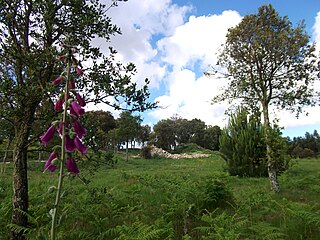
The Paesuri or Paesures were an ancient pre-Roman people of Lusitania, akin to the Lusitani, to whom they were a dependent tribe.

The Paesuri or Paesures were an ancient pre-Roman people of Lusitania, akin to the Lusitani, to whom they were a dependent tribe.
Mentioned by Pliny the Elder [1] and by a local epigraphic source, the 2nd Century AD Ponte de Alcântara inscription, near Cáceres, [2] along with the other Lusitani tribes, their ethnic and Linguistic affiliation has not yet been fully determined. It has been suggested that the Paesuri were of Thracian origin, [3] though to what extent they were celticized by their neighbors, the Lusitani, Gallaeci and Turduli Veteres, remains unclear.
Located between the rivers Douro and Vacua or Vagua (Vouga), in the modern northern central Portugal, the Paesuri comprised four subtribes – Ireucutiori, Aravoni, Seareae and Paesicaeci or Paesici – which settled the mountains of Freita, Arada, and the northern slopes of Caramulo around the 5th Century BC.
Like their neighbours the Turduli Veteres and Gallaeci, the Paesuri did not fell under Carthaginian rule at the later 3rd Century BC and appear to have not taken part in the Second Punic War. It is still not clear if they played any significant role in the Lusitanian Wars of the 2nd century BC. Allied with the Lusitani, they bore the brunt of the first Roman thrusts into the Iberian northwest. In 138-136 BC Consul Decimus Junius Brutus certainly devastated their lands during his punitive campaign against the Lusitani and the Turduli Veteres. [4] Again the Paesuri suffered the same treatment in 61-60 BC, when they were forcibly incorporated into Hispania Ulterior province by the Propraetor Julius Caesar. [5]
They were later aggregated by Emperor Augustus into the province of Lusitania in 27-13 BC.

Lusitania was an ancient Iberian Roman province comprising part of modern Portugal and a large portion of western Spain. It was named after the Lusitanians, an Indo-European folk who lived in the region prior to the arrival of the Romans.
Endovelicus is the best known of the pre-Roman Lusitanian and Celtiberian gods of the Iron Age. He was originally a chthonic god. He was the God/Lord of the Underworld and of health, prophecy and the earth, associated with vegetation and the afterlife. Later accepted by the Romans themselves, who assimilated it to Pluto or to Serapis and made him a relatively popular god.
Lusitanian mythology is the mythology of the Lusitanians, an Indo-European speaking people of western Iberia, in what was then known as Lusitania and Gallaecia. In present times, the territory comprises most of Portugal, Galicia, Extremadura and a small part of Salamanca.
The Lusitanians were an Indo-European speaking pre-Celtic people living in the far west of the Iberian Peninsula, corresponding roughly to Central Portugal and some areas of modern-day Extremadura and Castilla y Leon, in Spain. After its conquest by the Roman Republic the land was subsequently incorporated as a Roman province named after them (Lusitania).

The Cynetes or Conii were one of the pre-Roman peoples of the Iberian Peninsula, living in today's Algarve and Lower Alentejo regions of southern Portugal, and the southern part of Badajoz and the northwestern portions of Córdoba and Ciudad Real provinces in Spain before the 6th century BCE. According to Justin's epitome, the mythical Gargoris and Habis were their founding kings.

The Celtici were a Celtic tribe or group of tribes of the Iberian peninsula, inhabiting three definite areas: in what today are the regions of Alentejo and the Algarve in Portugal; in the Province of Badajoz and north of Province of Huelva in Spain, in the ancient Baeturia; and along the coastal areas of Galicia. Classical authors give various accounts of the Celtici's relationships with the Gallaeci, Celtiberians and Turdetani.

The Tapoli or Tapori were an ancient Celtic tribe of Lusitania, akin to the Lusitanians, to whom they were a dependent tribe, living just north of the river Tagus, around the border area of modern-day Portugal and Spain.

The Turduli or Turtuli were an ancient pre-Roman people of the southwestern Iberian Peninsula.

The Turduli Veteres, translated as "Ancient Turduli" or "Old Turduli" were an ancient pre-Roman tribe of present day Portugal, akin to the Calaicians or Gallaeci and Lusitanians.

The Turduli Oppidani or Turdulorum Oppida, were a pre-Roman coastal people in present-day Portugal, related to the Turduli Veteres and akin to the Lusitanians.

Conímbriga is one of the largest Roman settlements excavated in Portugal, and was classified as a National Monument in 1910. Located in the civil parish of Condeixa-a-Velha e Condeixa-a-Nova, in the municipality of Condeixa-a-Nova, it is situated 2 kilometres (1.2 mi) from the municipal seat and 16 kilometres (9.9 mi) from Coimbra.

The Gallaeci were a Celtic tribal complex who inhabited Gallaecia, the north-western corner of Iberia, a region roughly corresponding to what is now the Norte Region in northern Portugal, and the Spanish regions of Galicia, western Asturias and western León before and during the Roman period. They spoke a Q-Celtic language related to Northeastern Hispano-Celtic, called Gallaecian or Northwestern Hispano-Celtic. The region was annexed by the Romans in the time of Caesar Augustus during the Cantabrian Wars, a war which initiated the assimilation of the Gallaeci into Latin culture.

Cividade Hill or Cividade de Terroso Hill with an elevation of 153 metres (502 ft) is one of the two hills next to the city of Póvoa de Varzim in Portugal.

Mirobriga or Mirobriga of the Celts was an ancient town in the westernmost part of Lusitania during the Iron Age and Roman Times that was mentioned by Pliny the Elder and Ptolemy.

Balsa was a Roman coastal town in the province of Lusitania, Conventus Pacensis.

The Bardili were a small, pre-Roman tribe of the Iberian Peninsula, and an offshoot of the widespread Turduli people, who lived in what is now southwestern Portugal in the 5th-1st centuries BC.

The Museu da Música is a museum in Lisbon, Portugal. The museum primarily features musical instruments; among its holdings is a 1725 Stradivarius cello once owned and played by King Luís I of Portugal (ruled 1861–1889.

Jeannette Nolen was a Dutch archaeologist who carried out extensive research in Portugal.